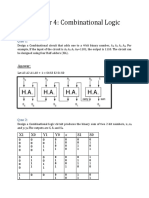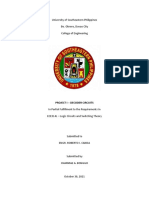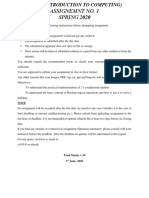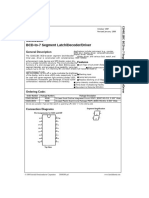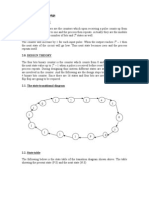seven segment
seven segment
Uploaded by
kencaroline447Copyright:
Available Formats
seven segment
seven segment
Uploaded by
kencaroline447Copyright
Available Formats
Share this document
Did you find this document useful?
Is this content inappropriate?
Copyright:
Available Formats
seven segment
seven segment
Uploaded by
kencaroline447Copyright:
Available Formats
lOMoARcPSD|50213003
7 segment display Lab 4 - nill
Electronics II (COMSATS University Islamabad)
Scan to open on Studocu
Studocu is not sponsored or endorsed by any college or university
Downloaded by Ken Caroline (kencaroline447@gmail.com)
lOMoARcPSD|50213003
Name: Fatma Alshammari
Course Name: EE/CS 327
Laboratory Assignment 4
Objective:
In this lab, we design and implement BCD to 7-Segment decoder.
The Seven segment display is most frequently used the digital display in calculators, digital
counters, digital clocks, measuring instruments, etc. Usually, the displays like LED’s as well as
LCD’s are used to display the characters as well as numerical numbers. But, a seven segment
display is used to display both the numbers and characters. These displays are frequently
driven by the output phases of digital integrated circuits like decade counters as well as
latches. However the outputs of these are in the type of 4-bit BCD (Binary Coded Decimal),
so not appropriate for directly operating the seven segment display. For that, a display
decoder can be employed for converting BCD code to seven segment code. Generally, it has
four input lines as well as seven output lines. This article discusses how to design a BCD to
seven segment display decoder circuit using logic gates.
BCD to 7-Segment Decode
7-Segment Display:
A seven-segment display (SSD) is a form of the electronic display device for displaying
decimal numerals. The seven elements of the display can be selected in different
combinations to represent the decimal numerals. Often the seven segments are arranged
in an oblique (slanted) arrangement, which aids readability. Seven-segment displays may
use a light-emitting diode (LED) or a liquid crystal display (LCD), for each segment, or other
light- generating or controlling techniques. There are two types of simple LED package 7-
Segment display:
Common Anode
Common Cathode
The Common Cathode Display (CCD):
In the common cathode display, all the cathode connections of the LED’s are joined
together to logic “0” or ground. The individual segments are illuminated by application of
a “HIGH”, logic “1” signal to the individual Anode terminals.
Downloaded by Ken Caroline (kencaroline447@gmail.com)
lOMoARcPSD|50213003
The Common Anode Display (CAD):
In the common anode display, all the anode connections of the LED’s are joined together
to logic “1” and the individual segments are illuminated by connecting the individual
Cathode terminals to a “LOW”, logic “0” signal.
Common Cathode and Common Anode Format:
Electrical connection of the individual diodes for a common cathode display and a common
anode display and by illuminating each light emitting diode individually, they can be made to
display a variety of numbers or characters.
Segment Display Format:
So in order to display the number “3” for example, segments a, b, c, d and g would need to
be illuminated. If we wanted to display a different number or letter then a different set of
segments would need to be illuminated. Then for a 7-segment display, we can produce a
truth table giving the segments that need to be illuminated in order to produce the required
character.
BCD to 7-Segment Display Decoders:
A binary coded decimal (BCD) to 7-segment display decoder such as the TTL 74LS47 or
74LS48, have 4 BCD inputs and 7 output lines, one for each LED segment. This allows a
Downloaded by Ken Caroline (kencaroline447@gmail.com)
lOMoARcPSD|50213003
smaller 4-bit binary number (half a byte) to be used to display all the denary numbers
from 0 to 9 and by adding two displays together, a full range of numbers from 00 to 99 can
be displayed with just a single byte of eight data bits.
BCD to 7-Segment Decoder:
Truth Table for a 7-segment display
7-Segment Display Elements for all Numbers.
7 A B C D a b c d e f g
Segmen
t
0 0 0 0 0 0 0 0 0 0 0 1
1 0 0 0 1 1 0 0 1 1 1 1
2 0 0 1 0 0 0 1 0 0 1 0
3 0 0 1 1 0 0 0 0 1 1 0
4 0 1 0 0 1 0 0 1 1 0 0
5 0 1 0 1 0 1 0 0 1 0 0
6 0 1 1 0 0 1 0 0 0 0 0
7 0 1 1 1 0 0 0 1 1 1 1
8 1 0 0 0 0 0 0 0 0 0 0
9 1 0 0 1 0 0 0 0 1 0 0
U 1 0 1 0 1 0 0 0 0 0 1
U 1 0 1 1 1 0 0 0 0 0 1
U 1 1 0 0 1 0 0 0 0 0 1
U 1 1 0 1 1 0 0 0 0 0 1
U 1 1 1 0 1 0 0 0 0 0 1
U 1 1 1 1 1 0 0 0 0 0 1
K-Map for a:
AB/CD 00 01 11 10
00 0 1 0 0
Downloaded by Ken Caroline (kencaroline447@gmail.com)
lOMoARcPSD|50213003
01 1 0 0 0
11 1 1 1 1
10 0 0 1 1
K-Map for b:
AB/CD 00 01 11 10
00 0 0 0 0
01 0 1 1 0
11 0 0 0 0
10 0 0 0 0
K-Map for c:
AB/CD 00 01 11 10
00 0 0 1 0
01 0 0 0 0
11 0 0 0 0
10 0 0 0 0
K-Map for d:
AB/CD 00 01 11 10
00 0 1 0 0
01 1 0 0 1
11 0 0 0 0
10 0 0 0 0
K-Map for e:
AB/CD 00 01 11 10
00 0 1 0 1
Downloaded by Ken Caroline (kencaroline447@gmail.com)
lOMoARcPSD|50213003
01 1 1 0 1
11 0 0 0 0
10 0 1 0 0
K-Map for f:
AB/CD 00 01 11 10
00 0 1 1 1
01 0 0 0 1
11 0 0 0 0
10 0 0 0 0
K-Map for g:
AB/CD 00 01 11 10
00 1 1 0 0
01 0 0 0 1
11 1 1 1 1
10 0 0 1 1
By using K-Map the expression for a, b, c, d, e, f, and g are given below
a = A` B` C` D + B C` D` + A B + A C
b= A` B D
c=A` B` C D
Downloaded by Ken Caroline (kencaroline447@gmail.com)
lOMoARcPSD|50213003
d=A` B` C` D + A` B D`
e=B` C` D + A` C D` + A` B C`
f= A` B` D + A` C D`
g= A` B` C` + B C D` + A B + A C
Code:
library IEEE;
use IEEE.STD_LOGIC_1164.ALL;
--------------------------------------------------------------
entity bcd_to_7seg is
--------------------------------------------------------------
Port ( A1,B1,C1,D1 : in STD_LOGIC;
a,b,c,d,e,f,g : out STD_LOGIC);
end bcd_to_7seg;
-------------------------------------------------------------
architecture Behavioral of bcd_to_7seg is
--------------------------------------------------------------
begin
a <= (Not A1 AND NOT B1 AND NOT C1 AND D1) OR (B1 AND NOT C1 AND NOT D1) OR (A1 AND B1) OR
(A1 AND C1);
b <= NOT A1 AND B1 AND D1;
c <= NOT A1 AND NOT B1 AND C1 AND D1;
d <= (NOT A1 AND NOT B1 AND NOT C1 AND D1) OR (NOT A1 AND B1 AND NOT D1);
e <= (NOT B1 AND NOT C1 AND D1) OR (NOT A1 AND C1 AND NOT D1) OR (NOT A1 AND B1 AND NOT
C1);
f <= (NOT A1 AND NOT B1 AND D1) OR (NOT A1 AND C1 AND NOT D1);
g <= (NOT A1 AND NOT B1 AND NOT C1) OR (B1 AND C1 AND NOT D1) OR (A1 AND B1) OR (A1 AND
C1);
end Behavioral;
Downloaded by Ken Caroline (kencaroline447@gmail.com)
lOMoARcPSD|50213003
Figure Show Circuit Diagram of a, b, c, d, e, f and g expression
Result:
For 4
Downloaded by Ken Caroline (kencaroline447@gmail.com)
lOMoARcPSD|50213003
For 5
For 8
For 9
Downloaded by Ken Caroline (kencaroline447@gmail.com)
lOMoARcPSD|50213003
For U
Critical Analysis / Conclusion:
In this lab I had designed BCD to 7-Segment decoder. As we know that a seven segment
display is a form of the electronic display device which is use for displaying decimal
numerals. Seven-segment displays may use a light-emitting diode (LED) or a liquid crystal
display (LCD), for each segment, or other light-generating or controlling techniques. There
are two types of simple LED package 7-Segment display. We can use common anode and
common cathode depending upon our device. This is a useful setup that can be applied to
any circuit where a count is required. It can be extended through additional counters and
decoders to count decimal with more digits (0-99 etc.). The addition of a real-time clock
could allow this to form the display of a digital clock.
Downloaded by Ken Caroline (kencaroline447@gmail.com)
You might also like
- ECE 120 Worksheet 5: From Problem Statement To Digital CircuitDocument4 pagesECE 120 Worksheet 5: From Problem Statement To Digital CircuitAnatasyaOktavianiHandriatiTata100% (1)
- CAPE UNIT ONE MODULE 2 Redox Equilibria Hand OutDocument4 pagesCAPE UNIT ONE MODULE 2 Redox Equilibria Hand OutLisa SawhNo ratings yet
- 7 Segment Display Lab 4Document9 pages7 Segment Display Lab 4FAseeh MalikNo ratings yet
- Quiz 2014, Questions and Answers Quiz 2014, Questions and AnswersDocument18 pagesQuiz 2014, Questions and Answers Quiz 2014, Questions and AnswersNồi NguyễnNo ratings yet
- DLD Final Lab ReportDocument10 pagesDLD Final Lab Reporthaiqa suhail100% (1)
- Chapter 4Document17 pagesChapter 4haiqa suhailNo ratings yet
- DLD Lab#08Document6 pagesDLD Lab#08Muhammad AliNo ratings yet
- PX 4211 Lab Front PageDocument94 pagesPX 4211 Lab Front Pageranjani SivaNo ratings yet
- CD4511BM/CD4511BC BCD-to-7 Segment Latch/Decoder/Driver: General Description FeaturesDocument10 pagesCD4511BM/CD4511BC BCD-to-7 Segment Latch/Decoder/Driver: General Description FeaturesAVINASHNo ratings yet
- CD4511 BCD To 7-Segment DecoderDocument9 pagesCD4511 BCD To 7-Segment DecoderBon Ndu OsonwanneNo ratings yet
- Circuit DesignDocument15 pagesCircuit DesignHafiezul HassanNo ratings yet
- Binary Decoder ProjectDocument12 pagesBinary Decoder ProjectCharmae BonggoNo ratings yet
- Digital Logic RecitationDocument8 pagesDigital Logic Recitationakayerdem00No ratings yet
- CS101-Assignmnet 1Document5 pagesCS101-Assignmnet 1M Noaman AkbarNo ratings yet
- CD4511BCDocument9 pagesCD4511BCsanchezacostaaitorNo ratings yet
- Melay and Moore and BCD and Excess 3Document11 pagesMelay and Moore and BCD and Excess 3win papasanNo ratings yet
- Tabel Encoder DecoderDocument6 pagesTabel Encoder DecoderRanda Kurniawan PNo ratings yet
- Digital Design Project 5 and Project 6 Synchronous Sequential Logic and Registers and CountersDocument10 pagesDigital Design Project 5 and Project 6 Synchronous Sequential Logic and Registers and CountersJanus Rau CunananNo ratings yet
- Practical 9DLDDocument3 pagesPractical 9DLDAbbas AbbasiNo ratings yet
- 6 PLC Program To Implement Binary To BCD ConverterDocument5 pages6 PLC Program To Implement Binary To BCD ConverterMaria GuerreroNo ratings yet
- ProjectDocument11 pagesProjectShadman ShalheNo ratings yet
- 9 PLC Program To Implement Binary To Gray Code ConversionDocument5 pages9 PLC Program To Implement Binary To Gray Code ConversionMaria GuerreroNo ratings yet
- Chapter 7 - Shift RegisterDocument35 pagesChapter 7 - Shift RegisterHumna DubbiiNo ratings yet
- Laboratorio 4 PDFDocument4 pagesLaboratorio 4 PDFAlberto VillazanteNo ratings yet
- Laboratorio 4 PDFDocument4 pagesLaboratorio 4 PDFAlberto VillazanteNo ratings yet
- Assignment 6Document5 pagesAssignment 6shubhayu.eee.20210205085No ratings yet
- DLD Exp 5Document8 pagesDLD Exp 5Muhammad UsmanNo ratings yet
- Exp 8 (DLD)Document4 pagesExp 8 (DLD)shah hassaanNo ratings yet
- Experiment:-7: AIM:-A.. Design A BCD To EXCESS-3 Code and Realize ItDocument6 pagesExperiment:-7: AIM:-A.. Design A BCD To EXCESS-3 Code and Realize ItAniket RatnakarNo ratings yet
- Digital DesignDocument4 pagesDigital DesignHasan CanarslanNo ratings yet
- ecbDocument3 pagesecbhejaz589No ratings yet
- ACTIVITY NO 7 Encoders - ELLINE PATAGANAODocument3 pagesACTIVITY NO 7 Encoders - ELLINE PATAGANAOElline PataganaoNo ratings yet
- Expt 06-1Document5 pagesExpt 06-1Aurongo NasirNo ratings yet
- DLD Project ProposalDocument21 pagesDLD Project Proposalmuibrahim.bee22seecsNo ratings yet
- Data Hasil Percobaan: Tabel 6.1. Encoder 10 To 4Document2 pagesData Hasil Percobaan: Tabel 6.1. Encoder 10 To 4daffa aldiNo ratings yet
- Mintermini Mapa Di KarnaughDocument13 pagesMintermini Mapa Di KarnaughJose Luis Munares RojasNo ratings yet
- Mit Assi 2Document5 pagesMit Assi 2Brian ThabwaNo ratings yet
- DLD Exp 6Document7 pagesDLD Exp 6Muhammad UsmanNo ratings yet
- Assignment Final DigitalDocument11 pagesAssignment Final Digitalkakandejonathan196No ratings yet
- KmapsDocument8 pagesKmapsSrinu TeluguNo ratings yet
- Counter DesignDocument5 pagesCounter DesignLarian RogasianNo ratings yet
- C421 Combinational Logic Part2 BDocument24 pagesC421 Combinational Logic Part2 BcolinNo ratings yet
- Working PrincipleDocument6 pagesWorking PrincipleBen TinNo ratings yet
- DLD Exp 4Document8 pagesDLD Exp 4Muhammad UsmanNo ratings yet
- Digital Logic Circuit Design Experiemnet 8Document8 pagesDigital Logic Circuit Design Experiemnet 8fahadNo ratings yet
- 3 Binary CodesDocument7 pages3 Binary CodesNoMercy 4 AllNo ratings yet
- Assignment 1Document41 pagesAssignment 1Sai BharathNo ratings yet
- Tabel Percobaan DastelDocument7 pagesTabel Percobaan DastelRenaldi IyanlebaNo ratings yet
- CS302PDocument2 pagesCS302Pbaigusama1997No ratings yet
- L8 Practice AnswersDocument3 pagesL8 Practice AnswersxxxNo ratings yet
- Experiment No.1 Aim: To Design and Simulate Transistor As An Amplifier. Circuit DiagramDocument12 pagesExperiment No.1 Aim: To Design and Simulate Transistor As An Amplifier. Circuit DiagramShashank BhatnagarNo ratings yet
- Logic Circuits & Switching Theory I: Quiz No.3 SET CDocument9 pagesLogic Circuits & Switching Theory I: Quiz No.3 SET CRussell ViadoNo ratings yet
- LCD Mod3Ass TUMALIUANDocument6 pagesLCD Mod3Ass TUMALIUANmaxpein100% (1)
- Experiment 3 - CSC 204 LabDocument7 pagesExperiment 3 - CSC 204 Lab2221634No ratings yet
- Subject: Vlsi Nano-Technology DevicesDocument5 pagesSubject: Vlsi Nano-Technology DevicesTanaya KatakkarNo ratings yet
- 312 COSCDocument5 pages312 COSCkelvinmuraya99No ratings yet
- Binary Hex CA SOPDocument11 pagesBinary Hex CA SOPGatesNo ratings yet
- BCD To Excess-3 Code ConverterDocument8 pagesBCD To Excess-3 Code ConverterAbd Almasah NabilNo ratings yet
- Tabel Tabulasi SoalDocument18 pagesTabel Tabulasi SoalMeysan DenisaNo ratings yet
- What's Cooking: Digital Transformation of the Agrifood SystemFrom EverandWhat's Cooking: Digital Transformation of the Agrifood SystemNo ratings yet
- Battery Electrolyte Experiments From Mango, Pineapple, and Dragon Fruit Waste Research PaperDocument29 pagesBattery Electrolyte Experiments From Mango, Pineapple, and Dragon Fruit Waste Research PaperKelvin SabastianNo ratings yet
- Elcobrandt Microwave Oven Technical TrainingDocument56 pagesElcobrandt Microwave Oven Technical TrainingNandor KermeciNo ratings yet
- Electrochemistry Introduction, Single Electrode Potential, Origin of Single Electrode Potential Theory, NernstDocument67 pagesElectrochemistry Introduction, Single Electrode Potential, Origin of Single Electrode Potential Theory, NernstShyam KiranNo ratings yet
- Corrosion: EngineeringDocument149 pagesCorrosion: EngineeringarielNo ratings yet
- Diodes For Power Electronic Applications: OutlineDocument25 pagesDiodes For Power Electronic Applications: OutlineChandan MandalNo ratings yet
- Biophysics Basics in ElectrotherapyDocument31 pagesBiophysics Basics in ElectrotherapyrabeyaNo ratings yet
- Capacitance-Voltage Profiling and The Character Is at Ion of III-V Semiconductors Using Electrolyte BarriersDocument22 pagesCapacitance-Voltage Profiling and The Character Is at Ion of III-V Semiconductors Using Electrolyte BarriersAkhil MehrotraNo ratings yet
- Electrolysis of Alumina-Refining of Aluminium-Hoop's MethodDocument3 pagesElectrolysis of Alumina-Refining of Aluminium-Hoop's MethodTatenda SibandaNo ratings yet
- 7 Lesson Plan On ElectrolysisDocument5 pages7 Lesson Plan On ElectrolysisboonyaucheongNo ratings yet
- IB HL Chemistry Assessment Statements Topics 9 and 19Document4 pagesIB HL Chemistry Assessment Statements Topics 9 and 19AndrewNo ratings yet
- EDC Unit-5Document26 pagesEDC Unit-5laxmanabcd100% (1)
- Nano Fuel Cell: Name: Shrawani Rithe Roll No:30 Subject Code: 22009 Branch: If-2IDocument12 pagesNano Fuel Cell: Name: Shrawani Rithe Roll No:30 Subject Code: 22009 Branch: If-2IvaradNo ratings yet
- AQA A-Level Physics Mark Scheme BankDocument13 pagesAQA A-Level Physics Mark Scheme Bankarychan418No ratings yet
- Generation of HHO and Its Effect On Engine PerformanceDocument5 pagesGeneration of HHO and Its Effect On Engine PerformanceNam stareNo ratings yet
- FME 007 Vertical Visualisation of Flow FieldsDocument1 pageFME 007 Vertical Visualisation of Flow FieldsInquiry XEEPLNo ratings yet
- Thesis Gloves For PWDDocument19 pagesThesis Gloves For PWDBrit BatoNo ratings yet
- Principios de Radiacion Goaz 1Document15 pagesPrincipios de Radiacion Goaz 1Alejo UrreaNo ratings yet
- Tube TopicsDocument31 pagesTube TopicsRicardo Jose PirelaNo ratings yet
- PDFDocument30 pagesPDFMihai RomulusNo ratings yet
- 4x4x4 LED Cube (Arduino Uno) - AllDocument24 pages4x4x4 LED Cube (Arduino Uno) - All108databoxNo ratings yet
- Balancing Interfacial Reactions To Achieve Long Cycle Life in High-Energy Lithium Metal BatteriesDocument10 pagesBalancing Interfacial Reactions To Achieve Long Cycle Life in High-Energy Lithium Metal BatteriesvivekdhandNo ratings yet
- Butler-Volmer EquationDocument3 pagesButler-Volmer Equationbeatriz100% (2)
- Corrosion by Other GasesDocument3 pagesCorrosion by Other GasesVinay Haridas75% (4)
- SL Paper3Document26 pagesSL Paper3Boshra NouriNo ratings yet
- Unit III BitsDocument6 pagesUnit III BitsShiva Krishna BhagavatulaNo ratings yet
- Tribhuvan University Institute of Engineering: Thapathali CampusDocument10 pagesTribhuvan University Institute of Engineering: Thapathali CampusJeevan khatryNo ratings yet
- Electricity AssignmentDocument4 pagesElectricity AssignmentAjit Kumar BeheraNo ratings yet
- An Accurate Photodiode Model For DC and High Frequency SPICE Circuit SimulationDocument4 pagesAn Accurate Photodiode Model For DC and High Frequency SPICE Circuit SimulationLucas Gabriel CasagrandeNo ratings yet
- M S Naidu, V Kamaraju High Voltage Engineering Tata McGraw Hill - CHDocument55 pagesM S Naidu, V Kamaraju High Voltage Engineering Tata McGraw Hill - CHamnaqahtan7342No ratings yet





